
Our present Phenomenally Low Interest Rate Era slips quietly into the next.
Interest rates will rise very, very, soon.
We sense the change, but wonder, what does this mean? For many here in Middle Earth, interest rates remain mysterious.
Fortunately, I found an ancient scroll during my sojourns in the Eastern Lands. Many nights, like the Grey Wizard Gandalf himself, I studied Isildur’s ancient texts, and translated that scroll from the Black Speech of the land of FOMC. I can now reveal the scroll to you, as it explains the mysteries of interest rates. My best translation:
Three rates for mortgage brokers under the sky
Seven for the bankers in their halls of stone
Nine for consumers doomed to die
One for the Yellen on her dark throne
In the land of FOMC where the money’s born
One rate to rule them all, one rate to find them,
One rate to bring them all and in the darkness bind them
In the land of FOMC where the money’s born.
To state a commonly held view1, the Fed funds rate (aka The One Rate To Rule Them All) goes up in September 2015. Or June 2015, I don’t know, they don’t tell me these secret things anymore. Soon, though.

Looking back from the future, we will recognize clearly the specialness of this Era, the Phenomenally Low Interest Rate Era.
We will see it as a halcyon time for some, such as prime mortgage and prime auto-loan borrowers.
(I still can’t believe I got a 2.75% 15 year mortgage!)
We will see it as a desert wasteland for people and institutions trying to live off scant bank or bond interest.
But wait, a Hobbit now pulls at my wizard sleeves. “What is an interest rate again?”

A bridge
An interest rate is a mathematical bridge linking money today to money in the future. Money today is always worth a different amount than money in the future. (This, according to the Wizards’ mysterious spell-chant known as ‘The Time Value of Money.’)
As the near-immortal High Elves of Middle Earth knew, the present ever-slips into the future.

Just as the Elves – sensing the end of their Age – passed wordlessly but inexorably into the West, so too does our money fade imperceptibly but inevitably in value as it slips into the future.
To make up for that loss, the wise ancients decreed that the borrower of money must always provide additional money in the future to the lender.
But how much additional money?
Ah! There you have it. ‘How much additional money?’ is exactly what an interest rate tells us.
If the interest rate is 6%, the borrower owes $6 for every one hundred dollars borrowed for a year. If the interest rate is 18%, the borrower owes $18 for every one hundred dollar borrowed for a year.
Back to Fed funds
Perhaps you’re also wondering, how does the Fed funds rate – aka The One Rate To Rule Them All – actually work?
We start with the fact that US banks are required to hold a certain amount of money, called “reserves,” at the Federal Reserve. Some banks may periodically have too much, or “excess reserves” with the Federal Reserve, while others may periodically have too little.
Banks with too little reserves – presumably temporarily – are allowed to borrow from banks with excess reserves.
The Federal Reserve (Well, a specific board known as the Federal Open Market Committee, made up of regional Federal Reserve Governors) sets a rate at which big banks may borrow that money, for just one day, from each other, using their own reserves held with the Federal Reserve.
A bank that needs money in the short-term – for making new loans, paying its lenders, or returning money to depositors for example – can borrow money overnight from banks that have this surplus sitting with the Federal Reserve.
That specific one-day interest rate – known as the ‘overnight rate’ since the loan from one bank to the other bank lasts ‘overnight’ for just one day – serves as the anchor for all other interest rates in the US dollar economy.
The Fed funds rate, currently set by the committee at a range between 0 and 0.25%, allows large commercial banks to borrow money very, very, cheaply. That cheap bank borrowing in turn fuels very cheap loans to the rest of us in Middle Earth.
Everyone who is not a bank, but who gets a bank loan, will borrow at an interest rate higher than the Fed funds rate, as determined by a combination of their bank and ‘the market’ for loans.
Since your bank can borrow money at 0.25%, it can choose to offer you the chance to borrow money pretty darn cheaply, while still making a profit.

The dwarves, burrowing in their mountains, borrow cheaply for mining operations. The elves borrow to maintain their palace at Rivendell with attractive home equity lines of credit. Halflings can fill up on ale, on credit, at The Golden Perch or The Green Dragon. The humans of Rohan maintain expensive cavalry regiments through their municipal bonds. Each race responds to the incentives of their particular interest rates. But those are all at rates set by the market. Only the Fed decides, by a small committee, the One Rate To Rule Them All.
If the Fed needs to nudge banks to lend to each other at or near its target rate, the Fed’s trading desk uses a market mechanism called “open market operations.” These are really market-based purchases or sales of bonds to soak up money or release money into the economy.
You could think of the Fed’s open market operations as analogous to the Strategic Petroleum Reserve that the federal government controls, periodically soaking up oil supply or releasing oil supplies, pushing oil prices up or down in the short run.
Something similar happens with the supply of money via bond purchases and sales, when the Fed wants to enforce its Fed funds rate or range.
Like the One Ring of Power, the Fed funds rate interacts with other key ‘Ring Bearers,’ such as mortgage bankers, commercial bankers, and consumer borrowers, each of whom in his own way determines the other interest rates in the economy of Middle Earth. All respond to the inexorable pull of the One Rate To Rule Them All.
Please enjoy subsequent (upcoming) nerdfest posts on this “Lord of the Rates” Theme.
LOTR Part II – Does the Fed ‘create money?’ How is Money Born?
LOTR Part III – Mortgage Rates
Related posts on similar themes:
My 2.75% mortgage, Timing, and I am a Golden God
Fiduciaries: Is It all Unsustainable Right Now?
Also, see related video posts
Video: Interest rates are a bridge linking money today to money tomorrow
Video: Interest Rates – Time Value of Money
Post read (1590) times.
- Ok, it’s really a Goldman Sachs economist’s view, but we all know who pulls the strings. Haha, kidding. Sort of. Not really. ↩




